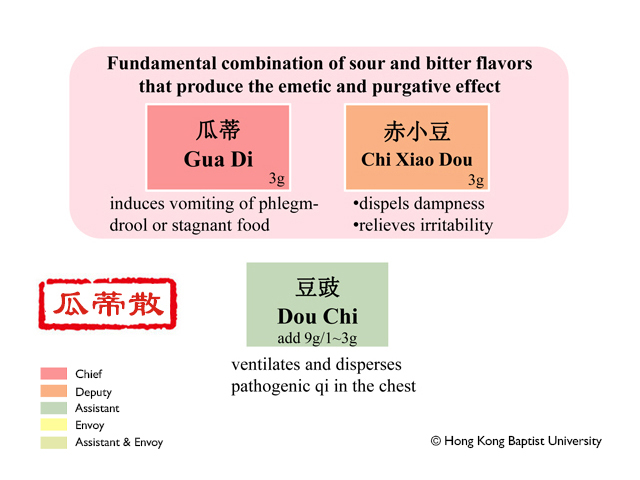|
|
 Chinese Medicinal Material Chinese Medicinal Material
|
| 【Chinese Name】 |
瓜蒂散
|
| 【Phonetic】 |
Gua Di San
|
| 【English Name】 |
Melon Stalk Powder |
| 【Classification】 |
Emetic formulas |
| 【Source】 |
《Treatise on Cold Damage》Shang Han Lun《傷寒論》 |
| 【Combination】 |
Melo Pedicellus (Gua Di) 1 fen (3g), Vignae Semen (Chi Xiao Dou) 1 fen (3g) |
| 【Method】 |
The source text states to grind equal amounts of the two medicinal into a fine powder and then sift them together. Take 2g of the mixture with a warm, strained decoction made from 9g of xiang dou chi. |
| 【Action】 |
Induces vomiting of phlegm or stagnant food. |
| 【Indication】 |
Gua Di San is indicated for pattern of phlegm-drool retained or food stagnation in the chest and stomach cavity. The symptoms are chest or epigastric distention and hardness, feeling of vexation, feeling the need to vomit but cannot, a feeling of qi rising to the throat that causes difficult breathing, and a pulse that is slightly floating at the cun position. |
| 【Pathogenesis】 |
Gua Di San is indicated for phlegm-drool retained or food stagnation in the upper part of the stomach cavity. Patients with this syndrome usually have qi stagnation because of the phlegm-drool or food retention in the chest and upper stomach. Therefore they suffer with symptoms such as fullness and hard mass in the chest, feeling of vexation, the desire to vomit but cannot, and breathlessness due to qi rushing up to the throat. The slightly floating cun pulse indicates that the pathogenic qi is located in the upper body. Tangible phlegm-drool and food retention in the chest are located in the upper region of the body and thereby have the tendency to exit from the upper body. We should work with this tendency in order to promote vomiting of the sputum and food retention. |
| 【Application】 |
1. Essential pattern differentiation
Gua Di San is the chief prescription used to induce vomiting. This clinical pattern is marked by fullness and hard mass in the chest, breathlessness due to qi rushing to the throat, vexation and restlessness, retention of toxic substances in the stomach.
2. Modern applications
This formula may be used in the following biomedically defined disorders when the patient shows signs of congested phlegm-drool: dilatation of the stomach due to food retention in the gastric cavity, toxic substances retained in the stomach and schizophrenia.
3. Cautions and contraindications
Gua di is a bitter, cold medicinal that is toxic, so it tends to damage stomach qi. It should be used cautiously for patients with conditions other than those with excessive form and qi. Gua di is forbidden to use once retained food has entered the intestines or if the phlegm-drool has left the chest. |
| 【Additonal formulae】 |
San Sheng San (Three Sages Powder 三聖散)
[Source]《Confucians' Duties to Their Parents》Ru Men Shi Qin《儒門事親》
[Ingredients] Fang feng 3 liang (5g), gua di (fried to yellow) 3 liang (5g), li lu 0.5 liang or 1 fen (3g) (subject to adjustment)
[Preparation and Administration] Grind the medicinals into powder and prepare it as decoction. The decoction should be taken slowly. Once vomiting appears, the decoction should be discontinued.
[Actions] Vomits wind-phlegm.
[Applicable Patterns] Wind-strike block. Symptoms include: aphonia, vexation, facial palsy, unconsciousness, lockjaw, frequent epilepsy caused by congested turbid phlegm in the chest and ascending counterflow, retained toxic substances in the upper stomach, and a floating, slippery and excessive pulse. |
|
|

|




